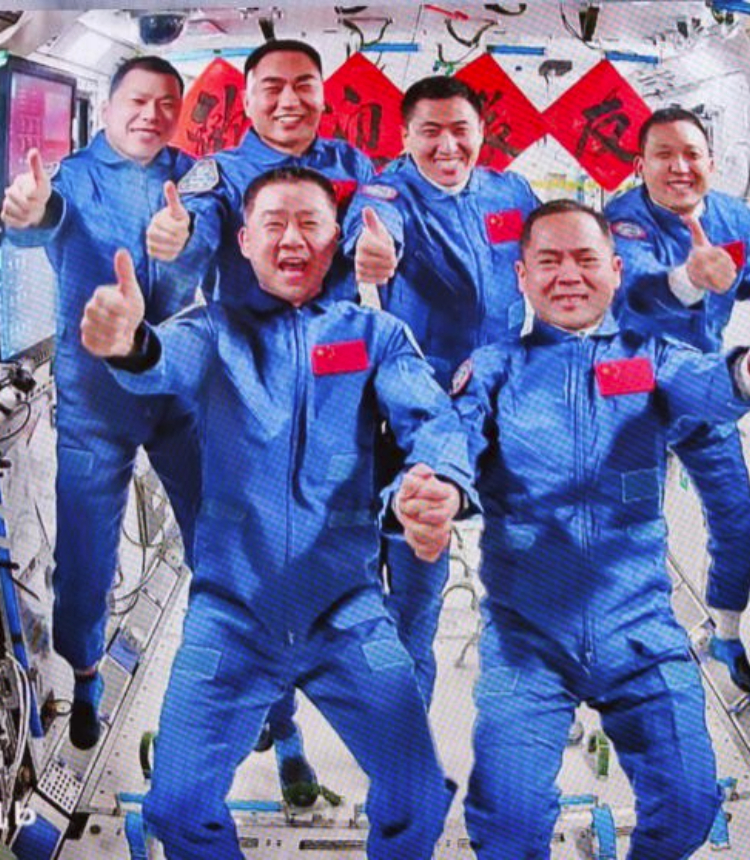Using newly introduced oven, taikonauts enjoy BBQ in orbit; significant improvement of work and life quality for long-haul space trips, experts say

This image captured at Beijing Aerospace Control Center on Nov. 1, 2025 shows a group picture of the crew of Shenzhou-20 and Shenzhou-21 spaceships. The three astronauts aboard China’s Shenzhou-21 spaceship have entered the country’s space station and met with another astronaut trio early Saturday morning, starting a new round of in-orbit crew handover. The Shenzhou-20 crew opened the hatch at 4:58 a.m. (Beijing Time) and greeted the new arrivals, according to the China Manned Space Agency (CMSA). The six crew members then took group pictures for the seventh space get-together in China’s aerospace history. They will live and work together for about five days to complete planned tasks and handover work, the CMSA said. (Xinhua/Jin Liwang)
Using a new oven installed on the China Space Station, crew members of the Shenzhou-20 and -21 manned space flight mission enjoyed a space barbecue, video clips provided by the Astronaut Center of China (ACC) to the Global Times on late Monday evening showed. According to the ACC, it is one of the new measures designed to further improve the life quality of taikonauts in orbit.
Chinese space experts said Tuesday the space oven could enable taikonauts to enjoy freshly cooked food in orbit, making them feel more like home in long-haul space trips.
The video footage showed that after a grill for 28 minutes, taikonauts of the Shenzhou-20 and -21 crew have their chicken wings ready to enjoy. Wang Jie and Wu Fei, respectively from Shenzhou-20 and -21 crew, also cooked the black peppered steak for Chen Dong, the mission commander of the Shenzhou-20 mission.
Liu Weibo from the ACC told the Global Times on Tuesday that after making technical breakthroughs in temperature control, residue collection, high-temperature catalysis, multi-layer filtration and other technologies, the oven achieves smokeless (oil-free) baking in orbit, meeting the space station’s oil smoke emission standards.
Also, the purification unit and the whole machine undergo rigorous testing to meet the space station’s entry requirements, enabling continuous and reliable operation for 500 cycles, Liu said.
The addition of an “oven” to the “space kitchen” is a heartwarming initiative to enhance the quality of life for taikonauts in orbit, the ACC said.
The International Space Station (ISS) previously tested a prototype oven built by NanoRacks and Zero G Kitchen, and cooked five chocolate chip cookies in orbit, marking the first food baked in space in a first-of-its-kind experiment back in 2020, according to the BBC.
Three of these cookies baked in orbit were later returned to Earth aboard a SpaceX Dragon spacecraft on January 7, per the report.
According to the BBC, ISS astronauts found that, in space, it takes more time to bake. The first cookie - baked for 25 minutes - was undercooked, but the second – baked for 75 minutes - released a fresh scent in the ISS.
The fourth and fifth cookies - one baked for 120 minutes and cooled for 25 minutes, and the other baked for 130 minutes and left to cool for 10 minutes - were deemed to be the most successful, the BBC report revealed.
By comparison, the China Space Station’s new oven roasted chicken wings in just 28 minutes, suggesting stronger heating performance than the ISS unit, Wang Yanan, chief editor of Aerospace Knowledge magazine, told the Global Times, on Tuesday.
It also shows that ground teams have conducted sufficient experiments to make sure that the oven ready for actual daily use, rather than deploying an experimental prototype like the ISS one, Wang noted.
Technically speaking, when the ISS baked cookies back then, it was not surprising that they ended up undercooked due to weak thermal convection and uneven temperature fields in microgravity, Kang Guohua, a senior member of the Chinese Society of Astronautics and a professor of Aerospace Engineering at Nanjing University of Aeronautics and Astronautics, told the Global Times.
Our space oven, however, was designed from the outset with full consideration of the space station’s energy compatibility, uniform heat distribution, and safety. We built on prior experience and made extensive optimizations, Kang noted.
The space station is not just a laboratory; it is also the taikonauts’ home. After work, gathering around a grill to enjoy a hot meal is a unique “romance” for Chinese astronauts. After completing demanding scientific tasks, a barbecue that soothes the soul is not just about satisfying the appetite - it’s also a way to stay “grounded” psychologically, Kang said.
The video of taikonauts enjoying a space barbecue has also drawn widespread attention and praise on Chinese social media. Many users contrasted the limited food options during China’s first manned mission, Shenzhou-5, with the freshly grilled chicken wings and steak now served in orbit, saying that “the remarkable improvement in space food reflects every step of the nation’s progress in space exploration.”
According to the ACC, during the Shenzhou-21 manned spaceflight mission, the variety of food has been expanded to more than 190 items, and the cycle of the flight menu has been extended to 10 days. On-orbit cooking and baking of ingredients such as fresh vegetables, nuts, cakes, and meat, has become reality.
Shenzhou-20 and -21 spaceflight mission crew have completed handover in orbit, per the China Manned Space Agency (CMSA) on Tuesday. During a handover ceremony on Tuesday, the key to the China Space Station has been passed on to the Shenzhou-21 crew.
The Shenzhou-20 crew will return to Earth on November 5. So far, the outgoing Shenzhou-20 crew has accomplished all scheduled tasks and will ride the Shenzhou-20 return capsule to return to the Dongfeng landing site on November 5, the CMSA said.